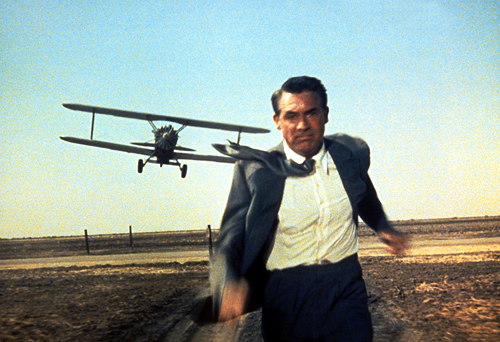Cary Grant is Roger Thornhill, an ordinary, mid-century, New York City adman in Alfred Hitchcock’s 1959 classic North by Northwest. Thornhill has little on his mind but his career, his girlfriends and his bar tab: the perfect 1950s bachelor’s (well, divorcée’s) existence.
Dangerous directions

Cary Grant is Roger Thornhill, an ordinary, mid-century, New York City adman in Alfred Hitchcock’s 1959 classic North by Northwest. Thornhill has little on his mind but his career, his girlfriends and his bar tab: the perfect 1950s bachelor’s (well, divorcée’s) existence.
He’s well-heeled and self-assured. He’s also attached to his mother. He tells his secretary, “In the world of advertising, there’s no such thing as a lie; there’s only the expedient exaggeration.” And as Thornhill becomes entangled in a net of Cold War spy games, he’ll have plenty of time to regret this assertion.
Thornhill gets mistaken for an American spy named George Kaplan by Russian agents. The logic these agents use to arrive at the conclusion that Thornhill is Kaplan is more than a little specious. They simply wait at his hotel and watch the dining room as the hotel staff page for “Mr. Kaplan…Mr. George Kaplan.” Thornhill unfortunately raises his hand to signal an attendant at the exact same moment the page sounds, and they assume he must be their man.
The agents pour a fifth of bourbon down his throat and send him careening down a mountain hill behind the wheel of a Mercedes Benz. Townsend cleverly defeats his intoxication-induced tunnel vision by using the Mercedes’ hood ornament as cross hairs to keep himself on the road.
The bad guys, one Phillip Vandamm (James Mason) and a creepy guy who’s gender we are later led to question known only as Leonard (Martin Landau), frame Thornhill for the murder of a U.S. ambassador to the United Nations. Now Thornhill is on the run from both the law and the spies with only his wits, charm and good luck to rely on.
The strikingly attractive and crazy talented Eva Marie Saint plays Eve Kendall, a sexy secret agent who seduces Thornhill and tries to kill him with a crop duster. Some of that aforementioned luck saves Thornhill’s skin in time, but there’s much more to come. And bless his heart, our hero doesn’t carry a gun.
Saint is sharp and humorous in her role as Kendall. She often has the beginnings of a wry smile playing on her alluring lips, and her timing is pitch perfect. Grant, as you may have heard, is no slouch himself, but he’s somewhat outshined in this work. He’s fluid enough, and he has a clever way of changing his gait and posture to suit the situations he finds himself in, like slouching his shoulders and shortening his step when he’s in the Illinois cornfields looking for the real Kaplan. But sometimes he hams it up.
Take, for example, the scene where the American intelligence agent, referred to only as “the professor,” clues him in to the fact that Kendall isn’t as bad as he thinks, and that her own life may be in danger (trust me, this ain’t no spoiler). Thornhill responds with a quick glance at the faraway and the exclamation, “Oh, no…!” He sometimes seems a little uncomfortable, as if he’s trying to compose himself in his smooth-fitting suit. He’s an actor in the tradition of “men looking cool onscreen,” a tradition he carries quite well.
He looks coolest when he’s with a lady, whether that lady is his secretary or Kendall. His mother, however, has the effect of emasculating him, but he still gets the chance to bribe her, reclaiming a bit of his autonomy. With Kendall, he quips his innuendos with gallant ease—as when he and she roll against the wall of her sleeper car’s berth in carnal embrace and he responds to her declaration that “I’m a big girl” with “and in all the right places, too.”
The film is worthwhile just for this clever intercourse, but some of these shots are too beautiful to be missed.
Consider the aerial view of the U.N. building’s facade and it’s modernist landscaped grounds as Thornhill makes his escape from the glass-and-steel-latticed skyscraper. (I can’t help but feel as if this top-down perspective view of a skyscraper must have inspired something…some contemporary cable TV series intro…) Or the shot of people streaming from the Mount Rushmore visitor center after he gets shot. The color and clarity in the re-mastered version really brings Hitchcock’s Technicolor cinematography to 21st century life.
The film is about sex, suspense, intrigue, and the Cold War. Tim Dirks at AMC’s filmsite.org suggests that the title refers to indeterminacy, since north by northwest is a direction, but it doesn’t have a specific delineation on a compass. This could refer to the politics of the Cold War as well. It was a war without a definite direction or a definitive goal, a war without fire but with plenty of ice-cold conspiracy.
The consequences of this type of ambiguous aggression include mistaken identity, wrongful prosecution and murder, and the film explores all these possibilities. That it does so with style and swagger shouldn’t obscure its heartfelt motivations.
Alfred Hitchcock’s North by Northwest (1959)
Friday, April 13, and Saturday, April 14, at 7:30 and 9:30 p.m.
Sunday, April 15, at 3 p.m.
Free for PSU students and faculty;
$2 other students and seniors;
$3 general admission





